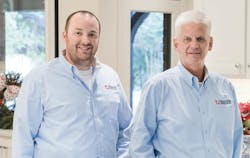Selling Your Company to Your Team
Y
ou’ve poured your heart and soul into building a successful business over decades and it’s time to think about how the journey will come to an end. Do you sell to an outsider? To family members? Should you try to create an ESOP (Employee Stock Ownership Plan)?
Or, you could approach a key team member to find out if they are interested in buying the business.
If they say yes, the next step is reaching an agreement on valuation. That can be a jarring experience, says Mark Richardson, an industry advisor who has guided multiple remodeling companies through the sales process.
Many owners overestimate the value of their business, Richardson says. “Sometimes they are a little delusional about it,” he explains. “It’s not like a piece of real estate that appreciates over the years. They think if it is a $2-3 million business, it must be worth $10-15 million. But in reality, it may be worth just $500,000.”
After settling on a valuation, several other points, including the mechanism of the ownership transfer, timing, and whether the current owner will be retained in some capacity, must be ironed out. Here’s how three remodeling businesses have addressed ownership transitions. Their experiences are instructive for others facing this challenge.
Traver Construction
Traver Construction Valuation: (Average 3-Year Profit + Average 3-Year Owner’s Comp) x 3
Doug Traver launched his Dallas-area company, Traver Construction, in 1990. When it came time for him to think about stepping aside, Traver had a key employee, Neil Bubel, waiting in the wings. Bubel was an experienced project manager with a strong grasp of how the business functioned.
“I had been thinking that I would start my own business someday,” Bubel says. But the notion of buying Traver Construction held appeal. With a good reputation, decades of satisfied customers to provide referrals, and established operational procedures, there was value in continuing the business instead of starting another from scratch. “I figured taking over Traver would give me a two-to-three-year head start,” Bubel explains.
A business purchase requires careful consideration and Bubel needed time to think about the pros and cons.
“We spent three or four years talking about it,” he recalls. As is the case with many sales of remodeling firms, determining the value of the business is a key exercise that often doesn’t lend itself to a quick answer.
The pair agreed to have Richardson suggest a method to value the firm. That formula was take the average profit over the past three years, add it the average owner’s compensation and multiply that number by three.
That figure was the basis of the valuation. “We also considered things like my sweat equity,” Bubel says. Time and effort Bubel had put in over the years was factored into the valuation, reducing the total sale price.
To facilitate the sale, Traver issued a note and Bubel makes payments quarterly.
The deal also had a provision for Traver to continue working for the firm, a mutually beneficial arrangement.
Traver continued to draw a salary while he transferred essential knowledge about running the company to Bubel. “We spent a lot of time fine-tuning processes and getting what was in his head onto paper,” Bubel says. During this period, the pair dove into to critical issues such as how Traver handled accounting, leads, and warranties.
In 2020, after two-and-a-half years, Traver stepped back and the ownership transition happened seamlessly. “One day he was signing checks, the next day I was,” Bubel says.
Traver continues to serve as a part-time consultant, earning an hourly rate. He comes to the office at least one day a week, spending much of his time advising Bubel on strategic decisions.
Overall, the ownership transition has gone smoothly, and Bubel attributes the success to a good rapport between himself and Traver. “The important thing is having someone you can communicate well with,” he says. Bubel’s knowledge of how the company functioned from years of working on the inside was also crucial.
“It would be tough to buy the business if you didn’t know how it ran,” he says.
Custom Design & Construction
Custom Design & Construction Valuation: (Average 4-Year EBITDA) x 4 - 20%
Bill Simone launched Custom Design & Construction in 1986, and by 2018, after three decades building a successful business in the Los Angeles area, he felt it was time to plan an exit.
“I had been solicited by a number of business brokers to sell,” he says. “They track the age of companies to look for prospects interested in selling.”
Yet, brokers typically work in multiple industries and don’t understand the nuances of the remodeling business. Selling to an unknown buyer through this method may not yield full value to a seller, and the buyer, who could be someone without remodeling experience, might not be able to maintain the business’ good name, Simone reasoned.
“Another option was to just shut down,” he says. “That was the least appealing choice. I still felt an obligation to honor warranties to clients.” In addition, pride in the company he created made him resist the idea of just letting it die out.
The best option was an internal sale, and there were two long-time employees—Beth Rubin and Santos Mejia, who were logical choices to take over. “They both had the company logo tattooed to their hearts,” Simone says.
In 2018, Simone proposed a sale to the pair and they were receptive.
After about 18 months of negotiations, the parties struck a deal. The agreement was scheduled to be inked just before the Covid pandemic, and the lockdown created great uncertainty. “They were concerned about what was going to happen to the company and the economy,” Simone recalls. “The deal sort of fell apart.”
It took a year to restart meaningful discussions about a sale, and after some talks a deal was inked.
Part of the appeal of buying the company for Rubin and Mejia was the ability to acquire Custom Design & Construction’s contractor’s license that was issued in 1988. California issues these licenses sequentially, so a smaller license number signifies a business with many years of experience. There was value in retaining that number along with the company’s name recognition and track record, Simone says.
Valuing the company was a fairly straightforward process. The parties agreed to base the number on the average EBITDA (earnings before interest, taxes, depreciation, and amortization) over the past four years and multiply that figure by four. Simone also offered a 20% discount on the sale price “as a thank you for all of their years of support and effort.”
Simone had structured the company as a closely held C corporation which made it easy to transfer shares. The parties agreed on a two-step ownership transfer. The first payment for 49 percent of company shares would come from corporate profits to be paid in installments that included principal plus interest. “Once they paid the first half, they could decide if they wanted to go forward with the second half,” Simone says.
The second payment for the remaining 51 percent of the firm was made in a lump sum. “We had planned on completing the deal over three years, but they made total payments in two years,” Simone recalls. The ownership transfer was concluded on Jan. 1, 2024.
During the two-year transition period, Simone stayed on board as a salaried employee. He spent most of his time as an advisor on higher-level decision-making. After the ownership transfer was completed, Simone was hired back in a part-time consulting role. He is not one to spend his days at a golf course, preferring to stay engaged with the firm and other ventures including consulting for other design build companies, and owning a financing company dedicated to specialty contractors.
Those endeavors keep him active an happy even though he has stepped aside from the day-to-day operations of a company that was his lifeblood for nearly 40 years.
Adams + Beasley Associates
Adams + Beasley Associates Vesting: (Average net profit over 36 months) x (multiplier) = Ownership value
The founders of Adams + Beasley Associates are many years away from retirement, but they are set up with an ownership structure that will benefit the firm when one or more of them are ready to exit.
Co-founders Eric Adams and Angus Beasley launched the Boston-area firm in 2006 and built the company to a 15-person team. In 2013, they collaborated on a few projects with Beasley’s brother, Nick, who helmed his own construction company, and Laura Burnes, the owner of an interior design/project planning firm.
The four-person team complemented each other, each bringing different skills to create a cohesive unit. They all realized they could have greater success by combining their firms. In 2016, they formalized a four-person leadership team and devised a plan for Nick Beasley and Burnes to acquire ownership stakes in Adams + Beasley Associates.
The new leaders would be granted equity in the firm via a five-year vesting plan with neither of them required to invest any cash for their ownership stakes. This arrangement was, in effect, a reward for the new partners’ sweat equity and the addition of their employees, contracts, and customer bases to the firm.
Adams says that acquaintances advised him that the new owners should pay cash for their stakes, but he and Angus Beasley took a long view, reasoning that the vesting arrangement would create happier partners and so result in a stronger firm.
“We were more committed to creating a company that would be sustainable and successful over the long term,” Adams says. “We were not trying to squeeze every last dollar out of it.”
To establish the vesting deal, the four leaders agreed to a standard valuation based on average profits over a few years with a multiplier, but soon decided on a modification that better reflected the company’s robust growth. Instead of a static backward-looking average profit model, they adopted a running 36-month net profit assessment that was adjusted each month. This meant the valuation would always reflect the most recent three-year EBITDA average, providing a truer gauge of the firm’s value.
Today, Nick Beasley and Burnes have fully vested to the agreed extent of ownership and are considering adding to their equity stakes. To acquire more shares, the pair will either pay in cash or through a percentage of their share of profits over time.
While it could be as long as a couple of decades before any of the four owners retire, the effort made on creating the current ownership structure and formal mechanisms for assigning equity shares will make ownership transitions much easier when that day comes, Burnes says. It will also be easier to grant additional employees ownership stakes, as the leaders have discussed recently.
“Because we went through the process of formalizing an equity share plan from two people to four, we have fewer questions about sharing equity with more employees,” Burnes says.
Expanding an ownership team presents potential challenges—more so than when selling a business to one or two employees. It is imperative that existing owners and new ones communicate well and get along. “Being able to compromise is an intrinsic part of it,” Adams says. Major decisions require consensus agreement which in turn means a collaborative spirit.
“You have to be really honest with yourself about the challenges and blessings about the people you work with and accept each one for who they are,” Burnes says.



